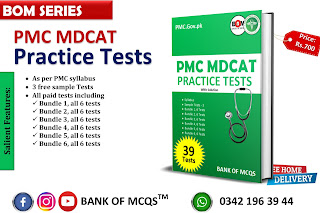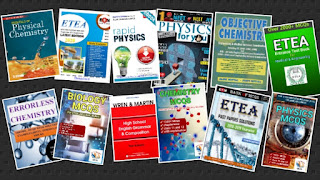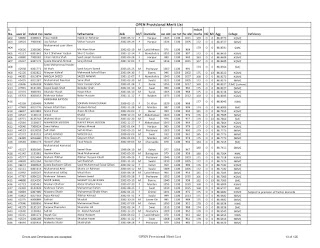Chapter no.1 stroichiometry MCQs with key for ETEA
1. Mass of an atom compared to one-twelfth the mass of one atom of C-12 is called
a. Molecular mass
b. Relative atomic mass
c. Formula mass
d, Non of these
2. One gram atom of any element contains
a. NA atoms b. 1K atoms
c. 1 atom d. Non of these
3. Gross contain …. Similar things
a. 12 b. 144
c. NA d. Non of these
4. Mole is
a. Atomic mass of element
b. Molecular mass of compound
c. Formula mass of formula unit
d. All of these
5. Equal volume of all gases, at same temperature and pressure, contain equal number of particles
a. Boyl’s law b. Charles law
c. Avogadro’s law d. Non f these
6. STP means
a. O0C, 1 atm b. 273K, 1 atm
c. 273K, 760 tor d. All of these
7. Percentage compositions =
a. (Total Mass of an element/total mass of compound)
b. (Total Mass of an element/total mass of compound) x 10
c. (Total Mass of an element/total mass of compound) x 100
d. (Total Mass of an element/total mass of compound) x 1000
8. Actual yield < theoretical because of
a. Reversibility b. Side reaction
c. Mechanical loss d. All of these
9. % yield =
a. (actual/theoretical) x 0.01
b. (actual/theoretical) x 10
c. (actual/theoretical) x 100
d. (actual/theoretical) x 500
10. Limiting reagent is one that is
a. consumed Earlier
b. consumed Later
c. remains constant
d. non of these
11. …… is obtained during experimental work
a. Actual yield
b. Experimental yield
c. Practical yield
d. All of these
12. The branch of chemistry that deals with calculations based on balanced chemical equations
a. Environmental chemistry
b. Physical chemistry
c. Stoichiometry
d. All of these
13. Which one is true for mole
a. Counting unit
b. Formula mass of substance
c. Contains 6.023 x 1023 particles
d. All of these
14. 5 moles of water contain
a. 18g b. 36g
c. 90g d. 100g
15. No of molecules in 22g CO2
a. 6.023 x 1023 b. 6.023 x 1021
c. 3.011 x 1023 d. Non of these
16. 22.4 dm3 at STP is volume of
a. SO2 b. H2
c. O2 d. All of these
17. Molar volume of CO2 at STP is
a. 22.4 dm3 b. 22.4 m3
c. 2.24 dm3 d. All of these
18. Theoretical yield is always less than actual because
a. Mechanical loss b. Side reaction
c. Human error d. Non of these
19. Actual yield will reach to theoretical yield if %yield is
a. 5 % b. 50 %
c. 100 % d. 1 %
20. The largest no of molecules are present in
a. 44g of CO2 b. 98g of H2¬SO4
c. 36g H2O d. 180g of C6H12O6
21. The percentage of Ca in CaCO3 is
a. 12 % b. 40 %
c. 48 % d. 100 %
22. The percentage of C in CaCO3 is
a. 12 % b. 40 %
c. 48 % d. 100 %
23. The sum of all percentages in CaCO3 is
a. 12 % b. 40 %
c. 48 % d.100 %
24. Chemistry is ……… science
a. Chemical b. Physical
c. Biological d.All of these
25. The percentage of O in C6H12O6 is
a. 40% b. 6.67%
c. 53.33% d. 100%
key
1. B
2. A
3. B
4. D
5. C
6. D
7. C
8. D
9. C
10. A
11. D
12. C
13. D
14. C
15. C
16. D
17. A
18. D
19. C
20. C
21. B
22. A
23. D
24. B
25. C
a. Molecular mass
b. Relative atomic mass
c. Formula mass
d, Non of these
2. One gram atom of any element contains
a. NA atoms b. 1K atoms
c. 1 atom d. Non of these
3. Gross contain …. Similar things
a. 12 b. 144
c. NA d. Non of these
4. Mole is
a. Atomic mass of element
b. Molecular mass of compound
c. Formula mass of formula unit
d. All of these
5. Equal volume of all gases, at same temperature and pressure, contain equal number of particles
a. Boyl’s law b. Charles law
c. Avogadro’s law d. Non f these
6. STP means
a. O0C, 1 atm b. 273K, 1 atm
c. 273K, 760 tor d. All of these
7. Percentage compositions =
a. (Total Mass of an element/total mass of compound)
b. (Total Mass of an element/total mass of compound) x 10
c. (Total Mass of an element/total mass of compound) x 100
d. (Total Mass of an element/total mass of compound) x 1000
8. Actual yield < theoretical because of
a. Reversibility b. Side reaction
c. Mechanical loss d. All of these
9. % yield =
a. (actual/theoretical) x 0.01
b. (actual/theoretical) x 10
c. (actual/theoretical) x 100
d. (actual/theoretical) x 500
10. Limiting reagent is one that is
a. consumed Earlier
b. consumed Later
c. remains constant
d. non of these
11. …… is obtained during experimental work
a. Actual yield
b. Experimental yield
c. Practical yield
d. All of these
12. The branch of chemistry that deals with calculations based on balanced chemical equations
a. Environmental chemistry
b. Physical chemistry
c. Stoichiometry
d. All of these
13. Which one is true for mole
a. Counting unit
b. Formula mass of substance
c. Contains 6.023 x 1023 particles
d. All of these
14. 5 moles of water contain
a. 18g b. 36g
c. 90g d. 100g
15. No of molecules in 22g CO2
a. 6.023 x 1023 b. 6.023 x 1021
c. 3.011 x 1023 d. Non of these
16. 22.4 dm3 at STP is volume of
a. SO2 b. H2
c. O2 d. All of these
17. Molar volume of CO2 at STP is
a. 22.4 dm3 b. 22.4 m3
c. 2.24 dm3 d. All of these
18. Theoretical yield is always less than actual because
a. Mechanical loss b. Side reaction
c. Human error d. Non of these
19. Actual yield will reach to theoretical yield if %yield is
a. 5 % b. 50 %
c. 100 % d. 1 %
20. The largest no of molecules are present in
a. 44g of CO2 b. 98g of H2¬SO4
c. 36g H2O d. 180g of C6H12O6
21. The percentage of Ca in CaCO3 is
a. 12 % b. 40 %
c. 48 % d. 100 %
22. The percentage of C in CaCO3 is
a. 12 % b. 40 %
c. 48 % d. 100 %
23. The sum of all percentages in CaCO3 is
a. 12 % b. 40 %
c. 48 % d.100 %
24. Chemistry is ……… science
a. Chemical b. Physical
c. Biological d.All of these
25. The percentage of O in C6H12O6 is
a. 40% b. 6.67%
c. 53.33% d. 100%
key
1. B
2. A
3. B
4. D
5. C
6. D
7. C
8. D
9. C
10. A
11. D
12. C
13. D
14. C
15. C
16. D
17. A
18. D
19. C
20. C
21. B
22. A
23. D
24. B
25. C







